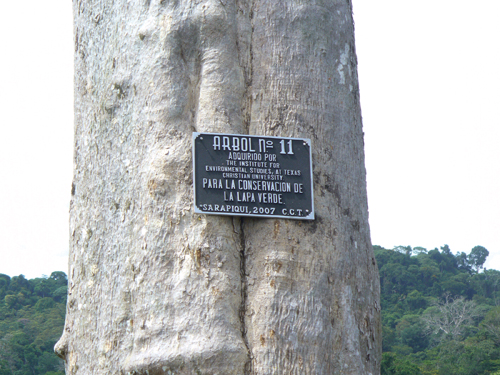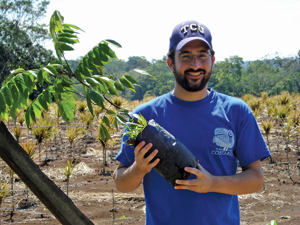|
Catch and release
Planting trees and releasing rescued birds are all in a day's work for students studying in Costa Rica.

By Nancy Allison
Alex Martinez swings into the minibus and says, "Hola." Somewhere between 45 and 60, the hardy Costa Rican wears sturdy boots with his shorts, even in this raging heat. He's guarding against a very possible encounter with a fer de lance, Costa Rica's deadliest snake. "I was bitten on the ankle by one just the other day," says the committed naturalist and volunteer game warden. "But luckily," he laughs, "I had my boots on."
Martinez runs a posada (lodge) from his home in Puerto Viejo de Sarapiqui, where he and his son Kevin give bird and wildlife tours. About eight years ago, he became concerned about the great green macaw. At that time, there were only 20 nesting pairs left in the country. The reason? Dipteryx panamensis, the tree they depend on to nest in and feed from, was disappearing.
As the van rolls along a red dirt road laced with potholes and switchbacks, Martinez explains that during the '80s, it became fashionable to have floors and furniture made of Dipteryx panamensis, commonly known as the almendro tree. Between that and the country's decision to pay citizens to clear their trees for pasture land, the tree grew scarce. The numbers of the great green macaw fell to a dangerous low.
Martinez decided to do something. He began working with Centro Científico Tropical to buy remaining almendro trees from farmers with active nesting sites who still had them on their land. This tree once took weeks to cut down with axes, and was nicknamed "tree of iron." Occasionally, they can still be found standing alone in acres of pasture land, a legacy of being so hard to cut down.
 Gretchen Wilbrandt has contributed to a new legacy regarding the almendro. In 2006 she spearheaded a campaign through the TCU Environmental Club for the great green macaw, throwing a concert that raised money for TCU to sponsor an almendro tree. In 2008, the group had a second concert and raised over $3,000. Gretchen Wilbrandt has contributed to a new legacy regarding the almendro. In 2006 she spearheaded a campaign through the TCU Environmental Club for the great green macaw, throwing a concert that raised money for TCU to sponsor an almendro tree. In 2008, the group had a second concert and raised over $3,000.
So far, TCU has bought one tree and is on the waiting list for two more. Martinez says that the great green macaw count has doubled over the past eight years. "People who fall in love with our country's wildlife and give their money and time to preserve it have made a difference. I want to thank you over and over for your gift," he tells Wilbrandt. "The growing macaw population is due in part to the interest of groups like yours."
A consequence of Martinez' work as a game warden is that he takes in many of the captured or wounded animals he encounters. He's said yes to so many animals that his wife has put her foot down, he jokes, and kicked him and the animals out. He's bought a 10-acre property about five miles from his home, where he is building a wildlife rehabilitation and rescue center.
Before running the Sarapiqui river this morning, the students planted 18 almendro saplings provided by Joanna and Alex 'Pongo' Baker, owners of the rafting company, Aventuras del Sarapiqui. "You are already helping to save one species of bird," Martinez tells the group. "Today I want to ask you to help another."
 Right now he has several birds in his charge: two owls recovering from gunshot wounds, a parrot with an infected wing, and about a dozen green parakeets to release back into the wild. Martinez helped to confiscate the parakeets from poachers who had planned to sell them on the black market. Right now he has several birds in his charge: two owls recovering from gunshot wounds, a parrot with an infected wing, and about a dozen green parakeets to release back into the wild. Martinez helped to confiscate the parakeets from poachers who had planned to sell them on the black market.
His rescue center, Tierra Hermosa, is on a former palm fruit plantation, which Martinez has already begun replanting with a mix of native saplings. In a few years, this area will be a haven for birds. He unlocks the two cages of parakeets, which look like miniature versions of their relative, the great green macaw.
The little birds ruffle their feathers and chirp once or twice, but seem very calm. As if they have rehearsed this scene throughout their lives, the students gently scoop up a bird and go to stand alongside Martinez facing the clearing.
There is a steep drop to pasture land below, but farther out the tree line beckons.
"Let them go on three," says Martinez. "Ready? Uno, dos, tres!" Arms and hands lift in one swift movement. As palms open, the birds catch the updraft, heading for the trees with a sudden chattering call.
The sound of human laughter fills the air, followed by a burst of spontaneous applause.
Birds have their multitudinous songs.
We have our own ways of signaling joy.

Comment at tcumagazine@tcu.edu. |



